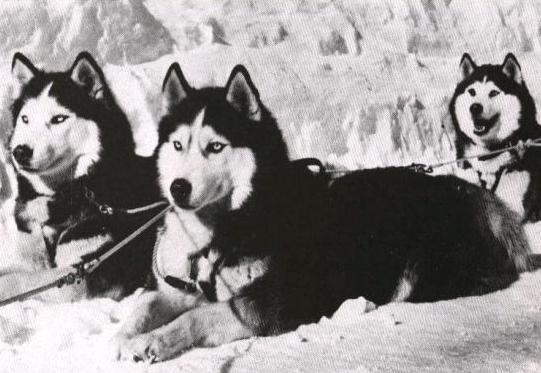MOSELEY TAYLOR BOUGHT "the Seeleys' matched team" for his wife after her first year of apprenticeship with mongrels. The team consisted of the progeny of the Duke x Tanta of Alyeska breeding and with it, Mrs. Taylor is said to have "entered the ranks of sled dog racing's top drivers," according to Michael Jennings, author of The New Complete Siberian Husky. She also began her dog show career in the 1930s, finishing Ch. Togo of Alyeska in 1939. In 1940 she registered the Monadnock affix and the following year gave her career a celebrity boost by divorcing Moseley Taylor and marrying Prince Nikolai Alexandrovitch Loupouchine-Demidoff.
Tosca of Alyeska was Lorna Demidoff's foundation bitch; she was bred to the pure Seppala studs Belford's Wolf and Vanka of Seppala, producing such early show champions as Ch. Panda, Ch. Kira of Monadnock and Ch. Kolya of Monadnock. Ch. Panda then gave the Monadnock line an additional Seppala boost by mating with Valuiki of Cold River and Ch. Vanka of Seppala 2nd from the Turner kennels, producing such dogs as the influential Ch. Vanya of Monadnock 3rd, Ch. Belka of Monadnock 2nd and Mitya of Monadnock. The next major contributor to the Monadnock bloodline was William Belletete's Izok of Gap Mountain, a three-quarters Seppala from a Cold River dam. Then in the mid-1950s Mrs. Demidoff acquired Mulpus Brook's the Roadmaster, an Izok son, from Jean M. Lane. In 1955 a triple-Izok inbreeding produced Ch. Monadnock's Pando, the dog who changed the face of the Siberian Husky breed. Also in the mid-1950s Lorna Demidoff retired from dogsled racing to devote herself to showing and breeding.
For years Mrs. Demidoff and Eva B. Seeley had vied to produce a black-and-white, blue-eyed, flashily marked dog that would be capable of winning beyond the breed level in Working Group and Best in Show competition. At first it appeared that Mrs. Seeley had won the competition with Ch. Alyeska's Suggen of Chinook, but the appearance of Ch. Monadnock's Pando entiredly eclipsed Eva B.'s early success. Pando and his sons dominated the show ring in the late 1950s and early 1960s; Pando's son Ch. Monadnock's King became the first Siberian Husky to win a Best in Show in the continental US (the trick had been done earlier in Alaska by Ch. Bonzo of Anadyr, CD). By the time of Pando's retirement from the show ring in 1966, his issue dominated show breeding to such an extent that of the 103 entries in that year's National Specialty, 100 were his descendants.

The contribution of Seppala lineage to Mrs. Demidoff's prestigious show bloodline is rarely discussed either in the show world or the Seppala orbit, being seen as somewhat of an embarassment to both. Harry Wheeler stock such as Wolfe of Seppala and Sapsuk of Seppala, the Poland Spring stud dog Belford's Wolf, and Marie Turner stock such as Duchess of Cold River and Valuiki of Cold River were integral to the development and success of the Monadnock bloodline. Yet despite the fact that such dogs as Ch. Monadnock's Pando were around 75% Seppala by ancestry, and had competent sleddogs in their pedigrees, cosmetic selection and the breeder vision of Mrs. Demidoff set the Siberian Husky on the path that led to its downfall as a working sleddog breed. There is a lesson to be learnt here, but few in either camp, show dog enthusiasts or present-day Seppala racers and cross-strainers, seem able to perceive it.
For most of the years of its active existence Monadnock was a "racing Siberian Husky" bloodline. It was three-quarters Seppala by ancestry. Its owner had a twenty-year racing career. Lorna Demidoff was (and is still) esteemed by many as "among the top women drivers of all time" (quoting Jennings). If Monadnock were around today, I would expect that many of those who indignantly deny the significance of McFaul/Shearer unique-Seppala origins would be insisting that Mrs. Demidoff's dogs should be considered Seppalas. The lessons of history are indeed difficult to learn.
SAMPLE PEDIGREE -- Ch. Monadnock's Pando(Opens in a new window.)
